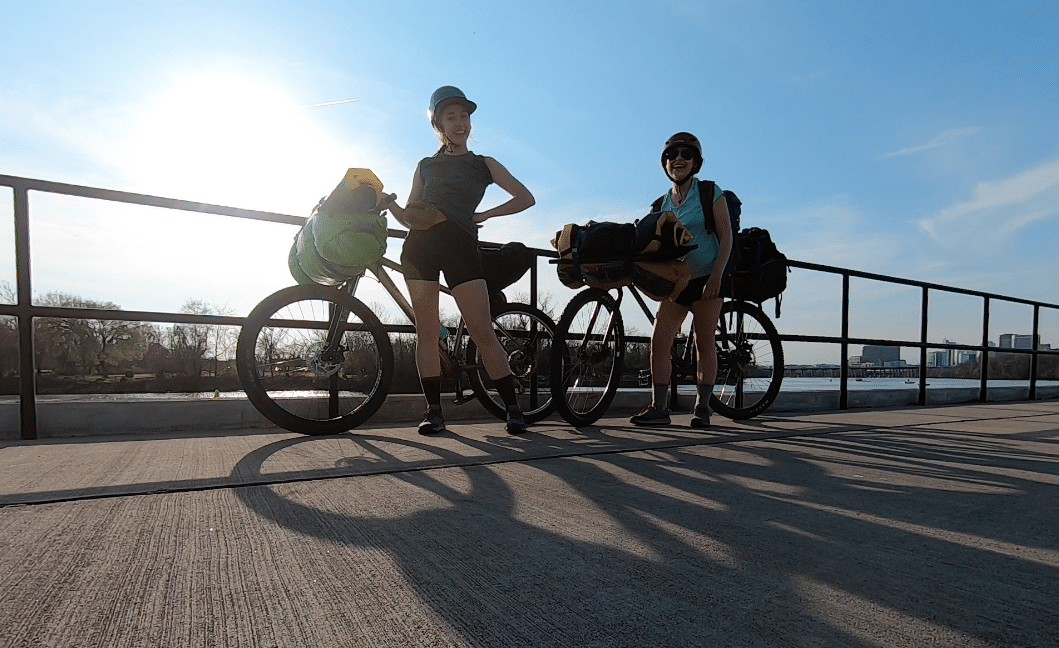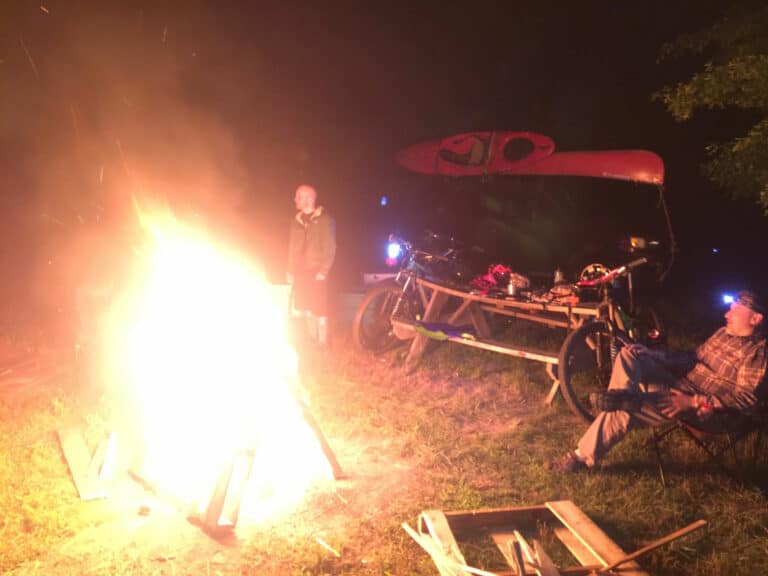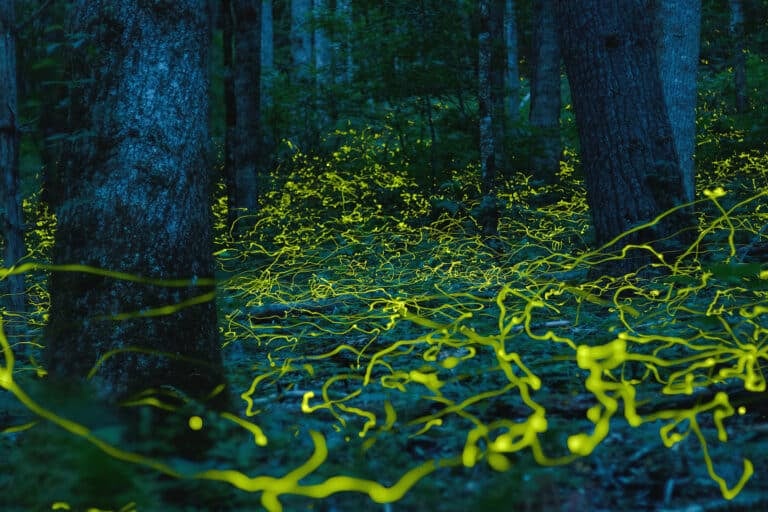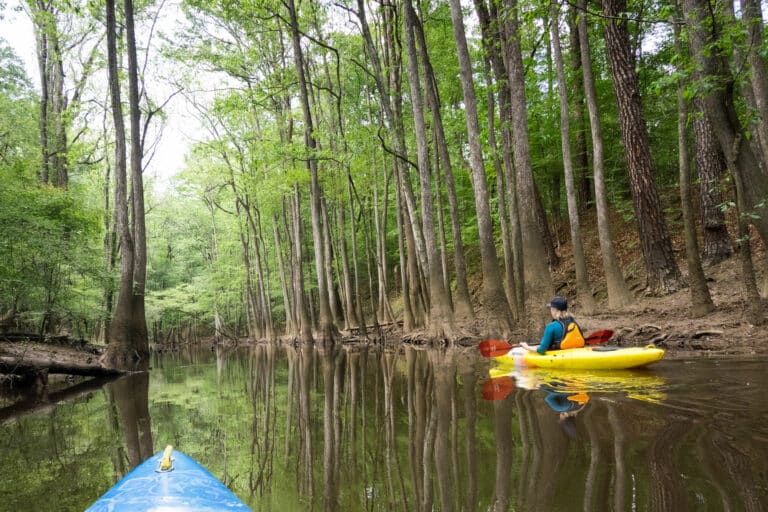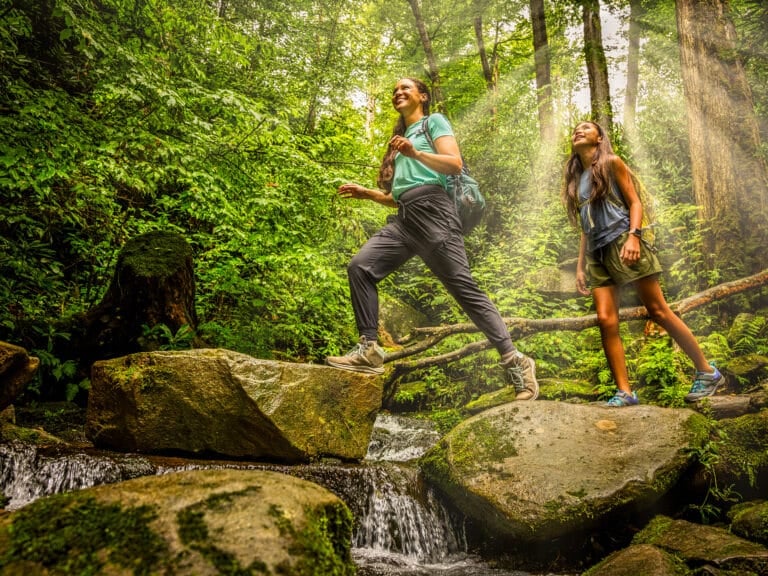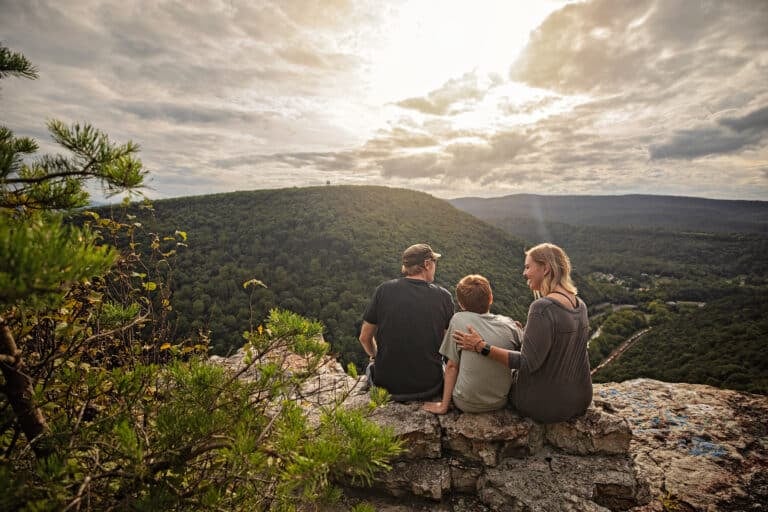A Self-Supported, Multi-Sport Adventure Right Out the Front Door
Earlier this year BRO Travel Editor Ellen Kanzinger and Digital Content Coordinator Shannon McGowan took a combined packrafting and bikepacking trip on the Lower James River and Virginia Capital Trail. Follow the journey, with insight on essential gear and what they learned along the way.
There’s a point on the Virginia Capital Trail as you start your descent into Richmond where the city skyline spreads out before you, welcoming you back from your journey. As we crested that hill, pedaling the last few miles home as the sun began to sink below the horizon, we felt that overwhelming sense of pride that comes from setting a goal and accomplishing it. Nothing but satisfaction from two days of hard work, and maybe a tiny bit of relief that we would be sleeping in our own beds that night.
When we first started planning this trip, we thought it was going to be about us—two friends planning a trip outside of their comfort zone while experiencing Richmond, Va., in a new way.
The idea was to design and complete a trip that was entirely self-supported. There would be no cars dropping us off at the boat ramp or shuttling us back home. We wanted to ride out the front door with nothing but our gear supported on our backs, bikes, and boats, and return the same way. And while we did accomplish that, paddling 18 miles of the Lower James River and biking 15 miles of the Virginia Capital Trail, it feels wrong to say that’s all it was.
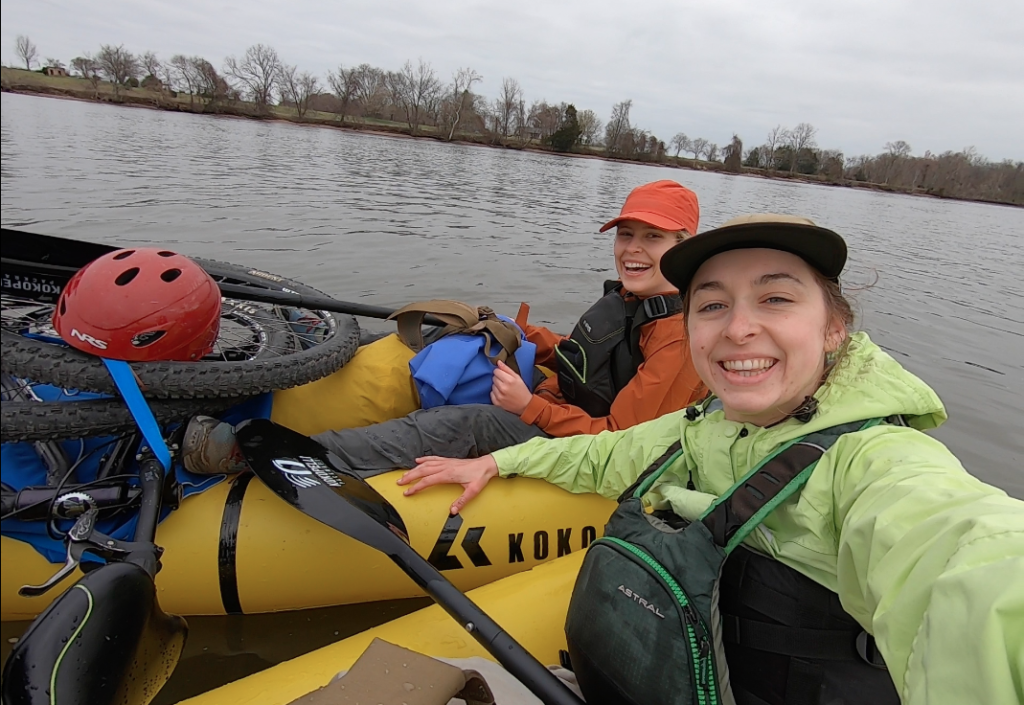
You see, this excursion was supposed to be a warm-up, a trial run for bigger things. We would only be gone one night, we wouldn’t have to paddle any rapids, and a majority of the biking would be on a paved greenway. This trip would give us the chance to test out all of our gear and make any changes before attempting a longer adventure. Once we figured out all of the kinks, we planned to do a similar trip in Asheville, N.C., paddling a section of the French Broad River and then biking back into the city. But we never got the chance.
COVID-19 hit the U.S. hard in mid-March and we started practicing social distancing. We cancelled our plans to avoid traveling and potentially spreading the virus. And we haven’t seen each other (in person) since. Although we didn’t get to test out our skills in Asheville, we will be ready to take what we’ve learned with us on our next trip into the great outdoors.
The Planning: It’s All in the Details
Ellen: As BRO’s travel editor, I write a lot about epic adventurers—hardcore athletes attempting ridiculous feats on the road, trails, and water. I am more of a fair-weather adventurer. I like hiking when the sun is out, a refreshing three-mile paddle on a summer’s day, and a bike ride around my neighborhood. When Shannon and I first started talking about doing a combo packrafting and bikepacking trip, I was a little apprehensive because I had never paddled or biked that far on one trip. But having Shannon with me, who has a lot more experience with changing flat tires and reading the water, helped ease my mind.
Shannon: Before I came to work at BRO, I was an outdoor guide and paddling instructor for years. Outdoor adventure was all I did for a while, so I was very excited to jump back into the process of getting out there. It was thrilling for my brain to go into planning mode again as it started flooding with thoughts of gear, supplies, strategies, and plans A through Z. Before this trip I had done plenty of overnight paddling and biking trips, but never both at the same time.
We must have considered over 10 different trips on rivers from Virginia to Georgia! For a while, it didn’t feel like we were getting any closer to making a decision until one day we realized a Richmond trip was the ideal practice trip. I am familiar with the area, we could easily call for help if needed, and the fact that we could take a safe and scenic bike path back was great.
PRO TIP: Figure out what needs you have for your trip and list them in order from top priority to low priority. Then see how different trips fit those needs. For each river we looked at, we had to consider how we would get there, camping spots, the river’s navigability, and what the traffic would look like on the bike routes. Since we put that work in, we have a bunch of ‘draft adventures’ that we can look at in the future!
The Adventure: 18 Miles of Paddling and 24 Miles of Biking
Ellen: I didn’t sleep very much the night before we left. I was too anxious, worrying that we had forgotten to pack some really important piece of gear or that the temperature would suddenly drop into the teens. But within a few minutes of getting on our bikes, I started to feel that anxiety give way to the excitement of heading out on an adventure. We left Shannon’s apartment while most of the city was still sleeping, so we practically had the streets to ourselves.
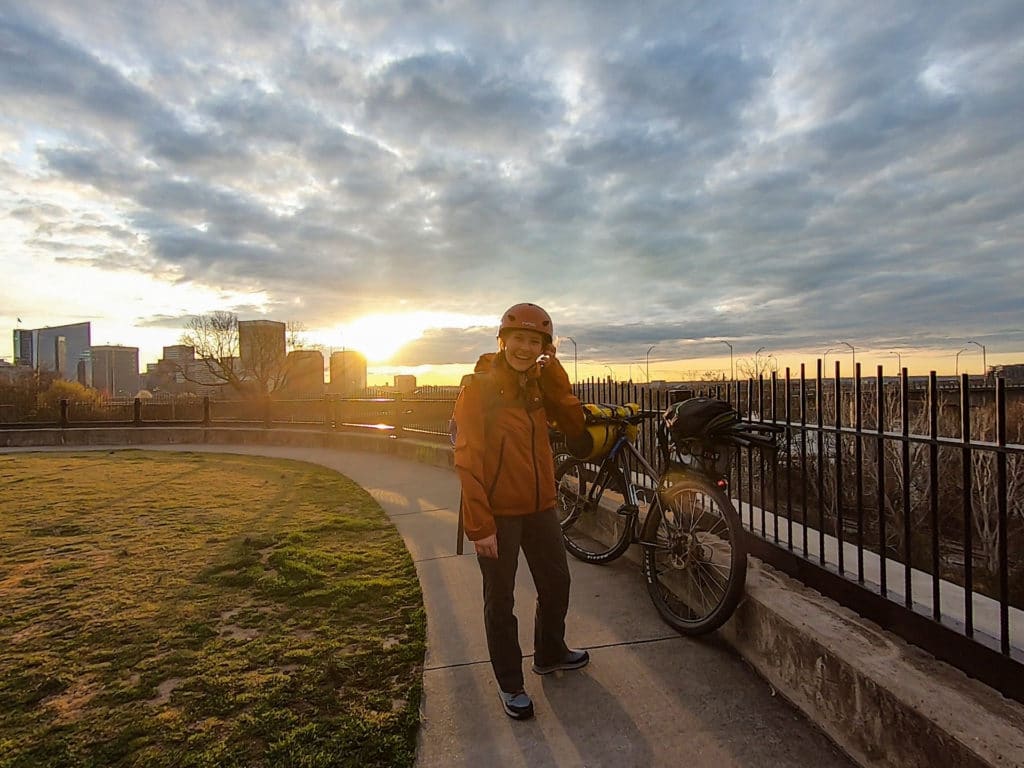
Shannon: The early morning take off of any adventure is my favorite part. The air is cool and crisp, the world still feels asleep, and you have a whole adventure ahead of you that will be filled with good stories and lasting memories. Plus, you get to look forward to how toned your muscles are going to feel after you complete the whole trip.
Our take off was a little clumsy as we needed to make slight adjustments to the bags that we stayed up late to attach the night before. It felt like the beginning of a comedic music montage where the inspirational music starts, then stops, then starts, then stops one more time, then finally we were off to the river.
Once we got to our put in at Ancarrow’s Boat Landing, we spent about 45 minutes figuring out how to attach our broken-down bikes to these inflatable rafts along with all of our gear. I remember thinking “awesome, that looks great! Now where TF is my butt going to go.” Once we got everything tied down and situated, we exchanged a celebratory high five and a few moments of “hell ya we got this we are such capable badass women!” Now came the moment we’d been waiting for… the takeoff.
We tip toed around the water’s edge and tried to finagle getting in without getting our feet wet. We were so ready for this big epic takeoff into the sunrise, and the extra time we put into staying dry added to the buildup. Careful… steady… PLUNK! Our butts plunked deep down into our boats causing a splash and zero forward momentum. Because I stored my dry bags in between my legs, my right foot spent the first four miles fully under water until I realized it was dragging.
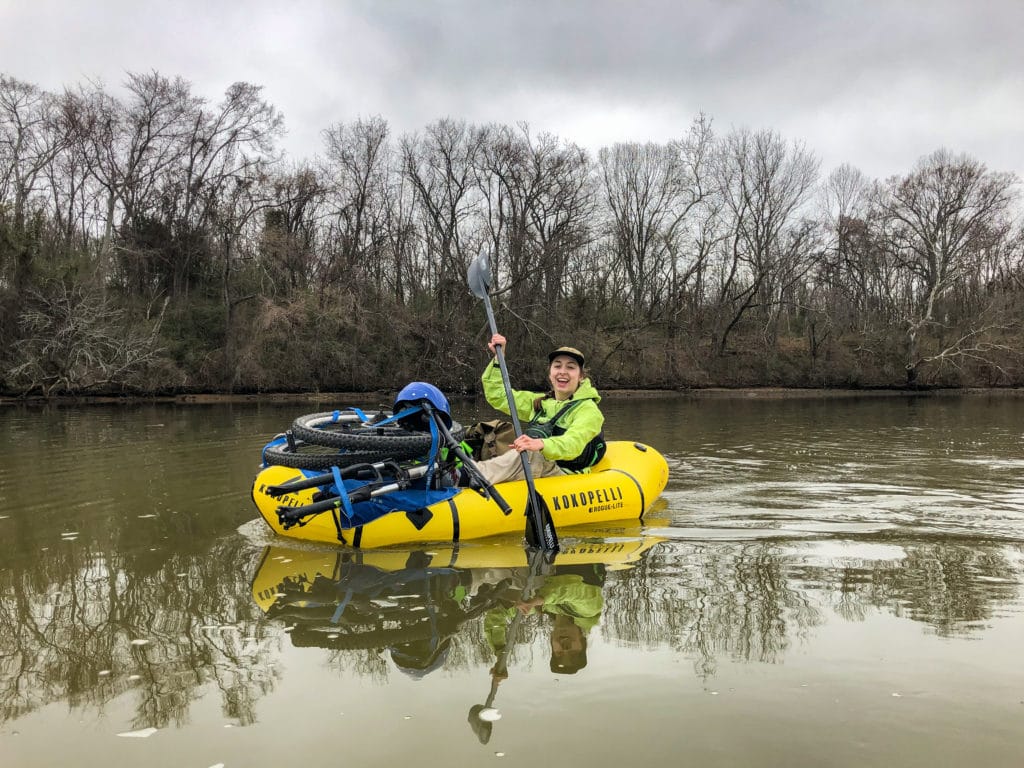
Ellen: The paddle started out great. The sun was shining with a nice breeze at our backs. We made pretty good time in the morning, stopping for lunch on the bank. And then the winds shifted and so did our luck. While we were finishing up our lunch, the current lifted my boat from the beach and started carrying it away. As we chased after it, I stepped in a hole and twisted my ankle. As I go down, I’m yelling at Shannon to leave me and save the boat! Through some masterful maneuvering, she got in her boat and herded mine back to shore. Now the second half of the day was a real struggle, paddling into the wind and racing the sunset. I almost started crying when we finally pulled into the cove and spotted our take out.
You know those videos of the astronauts getting out of their capsules after splashdown? The ones where they have to be helped out of the capsule by the divers? That’s how I felt getting out of the boat the first day after 13 miles of paddling. There was a family fishing off the dock at Henricus Historical Park, where we would be camping for the night. These amazing folks, the true heroes of this adventure, helped pull us and our rafts onto the dock as our muscles were screaming for us to give up. I don’t know how we would have gotten ourselves and all of our gear out of the water if they hadn’t been there, especially as we barely made it to our campsite before the sun completely set. Why did we think it was a good idea to paddle 13 miles on the first day?
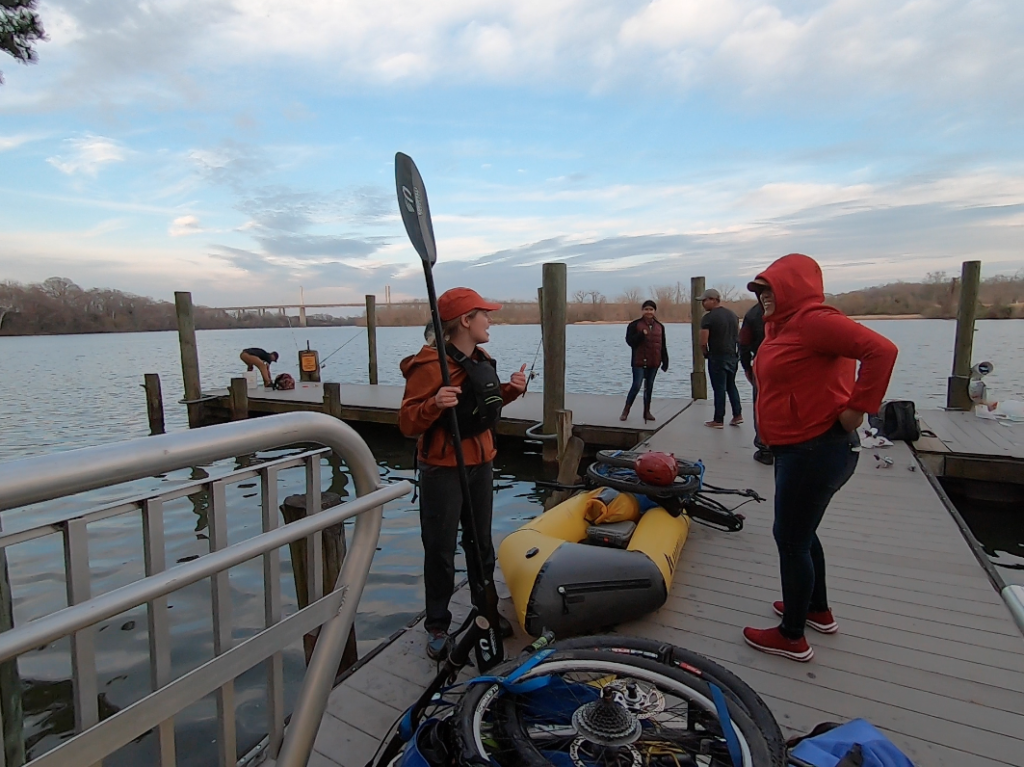
Shannon: After we got our sorry butts out of the water we stood before a long, paved ramp that led to the top of a huge hill where our campsite would be. I may be exaggerating how big this hill was, but after paddling 13 miles, looking at the amount of gear we would have to carry, my frozen hands, and Ellen’s injured ankle, that hill looked like Everest. After carrying everything to the top we were rewarded with a heated bathroom and hand dryers we could stand under! Score! After changing into warm dry clothes, we hung our hammocks, fashioned our ‘raccoon’ bag, and started cooking dinner.
We were the only ones at our campsite and had a really nice view of the James. Though as the sun started to go down, being the only ones there started to get in my head. The big stone cross got eerier and the idea of camping next to a settlement from the 1600s got spookier. I swore I kept hearing something in the woods a few times! But I didn’t want to force my spooks onto Ellen. I thought I was playing it cool enough that she wouldn’t notice I was being a chicken. I kept shining my light into the woods anytime I would hear something just to prove to myself that it was nothing. So, you can imagine my surprise when my flashlight eventually landed on a pair of eyes that was just feet from our camp!
Ellen: I am usually the one afraid of the dark. When I’m out camping, I try not to think about all of the other creatures I’m sharing the space with. Shannon was NOT playing it cool.
Shannon: I slept well in the hammock thankfully, but I woke up very sore from all the paddling we did the day before. We had a short day of 4 miles and were eager to knock it out and get on our bikes. Our put-in maneuvering was much more graceful than the day before. After just a two-day trip we came out feeling like pros in boat launching, gear tie downs, and packing. The second day of paddling offered more wildlife and natural views then the day before. We even saw a few eagles!
The bike ride was so much fun, both the actual ride itself and the great reward it offered in knowing you just did something really hard. Finishing our bike ride at Stone Brewery for a delicious beer and Nightingale ice cream sandwich was a pretty nice reward too.
Ellen: After 18 miles of paddling, I expected the biking to be no sweat. The majority of our miles would be on a paved greenway, so I wasn’t worried about traffic. But I had never ridden with anything other than a water bottle strapped to my bike. You really start to regret every ounce of gear you packed when you’re trying to pedal it up a hill.
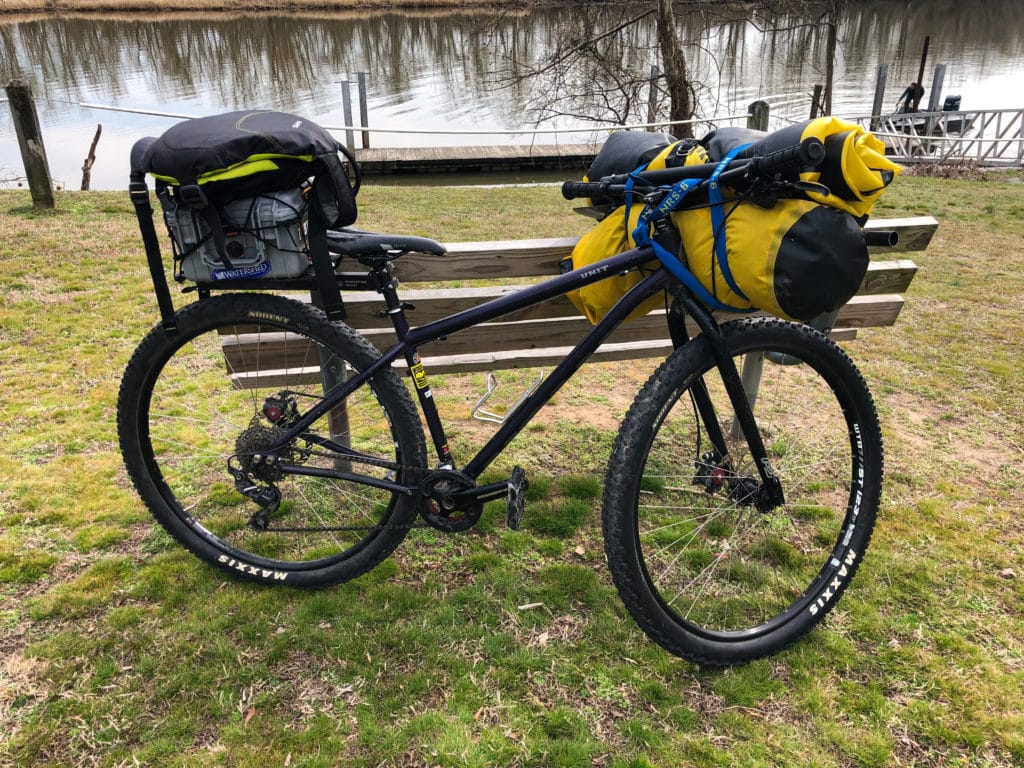
The Payoff: That Was Totally Wicked
Ellen: In comparison to other packrafting and bikepacking trips out there, ours was not that extreme. But that’s okay. It doesn’t have to include days of climbing gravel or paddling whitewater to still be an adventure. We spent two days immersed in the sights and sounds of the Lower James and Richmond, two days away from our phones and constant emails, two days of friends connecting outside. Even if some of that “nature” included a pack of raw sausage floating in the river, I’d call it an absolute success.
Looking back on our trip, it’s weird to think that we wouldn’t get to hang out with each other in person for a couple of months. When I left Shannon’s apartment, I told her I would see her in the office next week. Instead, that Monday, everyone in our office started working from home.
Shannon: The trip was long, challenging, and very rewarding. We had beautiful weather and the boats were easy to paddle, even with all of our gear. It was funny we chose this section for an outdoor adventure trip because, even though we did get to enjoy nature up close, we also got to experience some heavy-duty industrial structures that are easy to forget exist. We saw just as many barges and factories as we did birds and turtles. Big ass factories with signs warning us “Strong undertow. Back TF up.”
For most of our trip, we could see a road or highway. It was surreal to see society yet feel completely disconnected from it. I am so glad that we got to have such a fun trip together before entering this new way of life… And that the nickname “Ellen Bean” (inspired by Ellen’s small size and the toughness she shares with my L.L. Bean bike) came out of the trip.
The Itinerary: City to Woods
Day 1: We left the Fan District in Richmond around 7:30 a.m with all of our gear on our bikes. After riding 4.5 miles to our put-in at Ancarrow’s Boat Landing, we broke down our bikes and strapped everything to our boats. Then we paddled 13 miles down the Lower James River, past industrial parks and under towering bridges, to our campsite at Henricus Historical Park. There, we set up our hammocks, made a delicious pot roast dinner from a can, and spent a peaceful night amongst the trees.
Day 2: After breaking down our campsite in the morning, we paddled an additional 4.5 miles to our take out at Deep Bottom Park. To finish off our adventure, we biked the Virginia Capital Trail for 15 miles back into Richmond, stopping for a beer at Stone Brewing. We road another 4 miles back to Shannon’s apartment, arriving back home just as the sun set below the Richmond skyline.
The Gear That Got Us Here
Every adventurer knows that being prepared for any scenario can make all the difference. We packed all of our gear, clothes, and food into dry bags so they would stay dry on the river and in case of rain. Here are a few pieces of gear that made a difference on our trip.
Rogue-lite from Kokopelli
The inflatable Rogue-lite from Kokopelli was the perfect vessel for our packrafting adventure. It easily held the weight of our bikes and gear while also rolling up tight for easy attachment to our handlebars. When planning a trip like this, easy transition from bike to boat back to bike is key. The lightweight Feather air pump quickly inflated the boats in a matter of minutes. The Rogue-lite also comes with a Tizip option, increasing your storage space inside the packraft. Thank you to the folks at Kokopelli who shared the ins and outs of packrafting.
JungleLink Hammock Shelter System and Ember UnderQuilt from ENO
We decided to take a hammock sleep system so we wouldn’t have to pack tent poles. The ENO JungleLink Hammock Shelter System came with everything we needed to sleep through the night, including a rain tarp and built-in bug net. The Ember UnderQuilt added a layer of insulation to the outside of our hammocks to keep us warm from the breeze coming off of the river.
TR1 Mesh W’s from Astral
With a trip like this, we wanted shoes we could wear for paddling and biking so we wouldn’t have to pack two separate pairs. Astral’s TR1 Mesh W’s fit our needs perfectly. They are lightweight, dry easily, and provide excellent support. For paddling, we wore them with a pair of wool socks to keep our toes warm.
Taquito 20 and Nitro Quilt 800/20 from Sierra Designs
When it comes to deciding what sleeping bag to bring, it’s all about the temperature rating. Knowing that we were going in the middle of March and would be sleeping by the water, we went with bags with a 20-degree temperature limit. Both the Tacquito 20 and Nitro Quilt 800 from Sierra Designs fit our hammocks and provided the warmth we needed. Whether you go with a sleeping bag or a quilt, it is all up to your preference and sleep style. If you prefer tent camping, the Granby Insulated Sleeping Pad provides an excellent layer of insulation between your sleeping bag and the ground.
Bike parts from Blue Ridge Cyclery
The bike mechanic at Blue Ridge Cyclery worked with us for over an hour to find the best setup for our bikes so we could carry all of our gear, including a bike rack, extra tubes, a new repair kit, and some chain lube. They have it all. The rear bike rack was a huge lifesaver when Ellen’s saddle bag didn’t fit because she needed the seat all the way down!
Global Jacket and Boulder Pants from Topo
While we lucked out and avoided rain, Topo’s Global Jacket kept us warm during the chilly mornings and dry on the river. We stored phones, maps, and sunglasses in the many pockets. The water-resistant finish and stretchy waste line on the Boulder Pants made them the perfect pants for a variety of outdoor activities or just lounging around the campsite.
Bamboo Elements from UCO Gear
The Bamboo Elements mess kit from UCO Gear comes with a bowl/container, lid/plate, spork set, and reusable tether, perfect for whatever backcountry meal you’re cooking up. Everything fits together so that you don’t lose any of the pieces.
